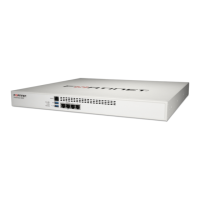
Do you have a question about the Fortinet FortiSIEM 500F and is the answer not in the manual?
| Brand | Fortinet |
|---|---|
| Model | FortiSIEM 500F |
| Category | Data Loggers |
| Language | English |
Describes the steps for a fresh installation of the FSM-500F appliance.
Instructions for physically mounting the FSM-500F appliance into a rack and connecting network cable.
Details on connecting power and turning on the FSM-500F appliance.
Steps to connect to the FSM-500F appliance and verify system information.
Guide to configuring FortiSIEM using the graphical user interface, starting with setting the timezone.
Selecting the geographical region and country for the appliance's timezone configuration.
Choosing the specific city within the selected country for accurate timezone settings.
Selecting the 'Collector' option as the target for configuration.
Choosing the installation option, such as 'install_without_fips'.
Inputting static IP address, Netmask, Gateway, and DNS Server details.
Configuring the collector's network parameters: Host Name, IPv4 Address, Netmask, Gateway, FQDN, and DNS.
Verifying network connectivity by pinging a host name or domain.
Reviewing and confirming all configured parameters before finalizing the setup.
Executing the configuration command with various parameters to set up the collector.
Instructions for registering the configured collector with the supervisor.
Steps to register a collector in an enterprise environment via the Supervisor UI.
Steps for service provider deployments, configuring the Event Worker IP.
Creating a new organization in FortiSIEM, defining administrative users and email.
Adding collector details like name, EPS, start/end time within an organization.
Registering the collector using a command-line script after UI configuration.
Reference to the FortiSIEM User Guide for detailed usage information.
Procedure to uninstall the FortiSIEM application from the FSM-500F appliance.
Steps to reinstall the FortiSIEM application using the 'execute factoryreset' command.
Information on upgrading the FortiSIEM Collector, referring to the Upgrade Guide.
Lists hardware and software prerequisites needed for re-imaging the FortiSIEM appliance.
Instructions to create a bootable Linux USB drive using Rufus and Ubuntu ISO.
Steps to format and copy the FortiSIEM Collector image file onto a USB drive.
Command to clean the FSM appliance and power it off before re-imaging.
Steps to set the appliance's BIOS to boot from the USB drive.
Procedure to use Linux from USB to re-image the appliance's boot drive.
Prerequisites required before performing the migration from an older FortiSIEM version.
Steps for installing and configuring the bootloader and image for migration.
Instructions to download the FortiSIEM bootloader from the support site.
Unzipping the downloaded bootloader package to prepare for installation.
Running the 'prepare_bootloader' script to install and configure the bootloader.
Interaction with the FortiSIEM bootloader shell after running the preparation script.
Steps to load the new FortiSIEM 6.1.2 image onto the appliance.
Logging into the bootloader shell with root credentials and changing the password.
Mounting the /opt directory and creating symbolic links for image management.
Executing the 'load_image' script to copy the new image to the target disk.
Copying essential configuration files to the /images directory for migration.
Steps to complete the migration process to FortiSIEM version 6.1.2.
Unmounting the /opt directory after completing file operations.
Executing configFSM.sh to start the migration configuration via GUI.
Configuring the timezone using the graphical interface during migration.
Selecting the geographical region and specific timezone for the migration process.
Choosing 'Collector' as the target for the migration configuration.
Selecting the 'migrate_6_1_1' option to initiate the migration.
Testing network connectivity to a known internet site before final migration.
Executing the final command to complete the FortiSIEM migration.
Explanation of the command-line options used for the migration process.
Restoring the HTTP password file from backup after migration.
Re-registering the collector to the supervisor using the update option.
Manually rebooting the appliance if it does not restart automatically after migration.